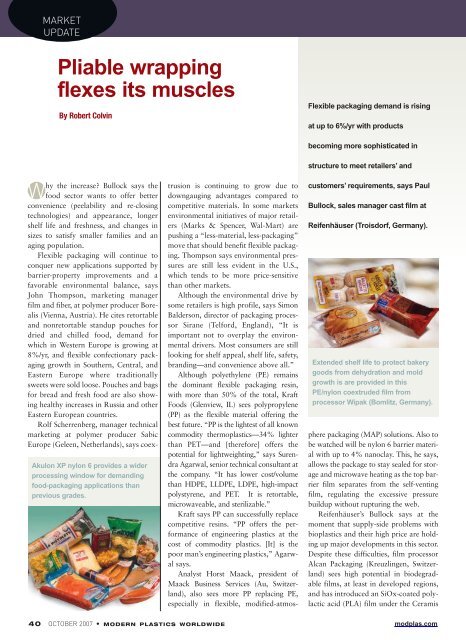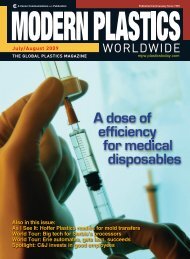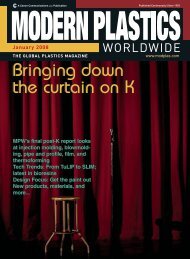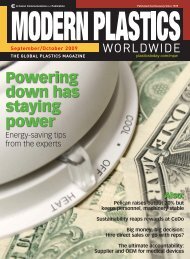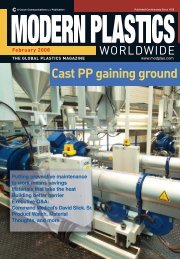Modern Plastics Worldwide - October 2007 - dae uptlax
Modern Plastics Worldwide - October 2007 - dae uptlax
Modern Plastics Worldwide - October 2007 - dae uptlax
You also want an ePaper? Increase the reach of your titles
YUMPU automatically turns print PDFs into web optimized ePapers that Google loves.
MARKET<br />
UPDATE<br />
Pliable wrapping<br />
flexes its muscles<br />
By Robert Colvin<br />
Why the increase? Bullock says the<br />
food sector wants to offer better<br />
convenience (peelability and re-closing<br />
technologies) and appearance, longer<br />
shelf life and freshness, and changes in<br />
sizes to satisfy smaller families and an<br />
aging population.<br />
Flexible packaging will continue to<br />
conquer new applications supported by<br />
barrier-property improvements and a<br />
favorable environmental balance, says<br />
John Thompson, marketing manager<br />
film and fiber, at polymer producer Borealis<br />
(Vienna, Austria). He cites retortable<br />
and nonretortable standup pouches for<br />
dried and chilled food, demand for<br />
which in Western Europe is growing at<br />
8%/yr, and flexible confectionary packaging<br />
growth in Southern, Central, and<br />
Eastern Europe where traditionally<br />
sweets were sold loose. Pouches and bags<br />
for bread and fresh food are also showing<br />
healthy increases in Russia and other<br />
Eastern European countries.<br />
Rolf Scherrenberg, manager technical<br />
marketing at polymer producer Sabic<br />
Europe (Geleen, Netherlands), says coex-<br />
Akulon XP nylon 6 provides a wider<br />
processing window for demanding<br />
food-packaging applications than<br />
previous grades.<br />
trusion is continuing to grow due to<br />
downgauging advantages compared to<br />
competitive materials. In some markets<br />
environmental initiatives of major retailers<br />
(Marks & Spencer, Wal-Mart) are<br />
pushing a “less-material, less-packaging”<br />
move that should benefit flexible packaging.<br />
Thompson says environmental pressures<br />
are still less evident in the U.S.,<br />
which tends to be more price-sensitive<br />
than other markets.<br />
Although the environmental drive by<br />
some retailers is high profile, says Simon<br />
Balderson, director of packaging processor<br />
Sirane (Telford, England), “It is<br />
important not to overplay the environmental<br />
drivers. Most consumers are still<br />
looking for shelf appeal, shelf life, safety,<br />
branding—and convenience above all.”<br />
Although polyethylene (PE) remains<br />
the dominant flexible packaging resin,<br />
with more than 50% of the total, Kraft<br />
Foods (Glenview, IL) sees polypropylene<br />
(PP) as the flexible material offering the<br />
best future. “PP is the lightest of all known<br />
commodity thermoplastics—34% lighter<br />
than PET—and [therefore] offers the<br />
potential for lightweighting,” says Surendra<br />
Agarwal, senior technical consultant at<br />
the company. “It has lower cost/volume<br />
than HDPE, LLDPE, LDPE, high-impact<br />
polystyrene, and PET. It is retortable,<br />
microwaveable, and sterilizable.”<br />
Kraft says PP can successfully replace<br />
competitive resins. “PP offers the performance<br />
of engineering plastics at the<br />
cost of commodity plastics. [It] is the<br />
poor man’s engineering plastics,” Agarwal<br />
says.<br />
Analyst Horst Maack, president of<br />
Maack Business Services (Au, Switzerland),<br />
also sees more PP replacing PE,<br />
especially in flexible, modified-atmos-<br />
Flexible packaging demand is rising<br />
at up to 6%/yr with products<br />
becoming more sophisticated in<br />
structure to meet retailers’ and<br />
customers’ requirements, says Paul<br />
Bullock, sales manager cast film at<br />
Reifenhäuser (Troisdorf, Germany).<br />
Extended shelf life to protect bakery<br />
goods from dehydration and mold<br />
growth is are provided in this<br />
PE/nylon coextruded film from<br />
processor Wipak (Bomlitz, Germany).<br />
phere packaging (MAP) solutions. Also to<br />
be watched will be nylon 6 barrier material<br />
with up to 4% nanoclay. This, he says,<br />
allows the package to stay sealed for storage<br />
and microwave heating as the top barrier<br />
film separates from the self-venting<br />
film, regulating the excessive pressure<br />
buildup without rupturing the web.<br />
Reifenhäuser’s Bullock says at the<br />
moment that supply-side problems with<br />
bioplastics and their high price are holding<br />
up major developments in this sector.<br />
Despite these difficulties, film processor<br />
Alcan Packaging (Kreuzlingen, Switzerland)<br />
sees high potential in biodegradable<br />
films, at least in developed regions,<br />
and has introduced an SiOx-coated polylactic<br />
acid (PLA) film under the Ceramis<br />
40 OCTOBER <strong>2007</strong> • MODERN PLASTICS WORLDWIDE modplas.com


